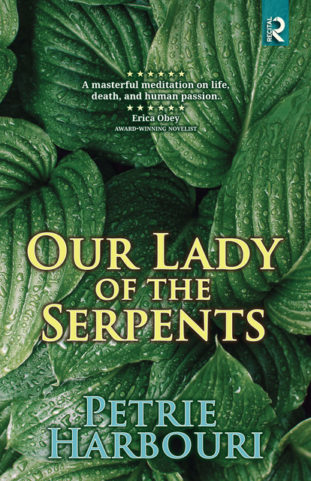OUR LADY OF THE SERPENTS
Petrie Harbouri
OUR LADY OF THE SERPENTS
Petrie Harbouri

OUR LADY OF THE SERPENTS
A novel
In a novel rich with erotic twists, like the sensuously entwined dance of mating snakes, Petrie Harbouri weaves a tale of love, lust and death; of rebirth and transformation.
“Reality is a false refuge,” the reclusive widow Chloe tells her lodger Robert, an Englishman taking time out from responsibilities back home. She employs him to tend her half-wild Mediterranean garden.
It is a garden of secrets, abundantly fertile and full of memories. In it a passionate love affair once took place. Past and present are linked by a web of allusions, both poetic and religious, and beneath it all lies a sense of the oldest goddess of all, the abiding, ageless Earth Mother.
Harbouri’s subtle and agile observational style provides insights into the feminine and masculine aspects of her central characters and the interplay between them. Our Lady of the Serpents explores and then subverts orthodox ideas of gender, uncovering a deeper, more existentially flexible, and possibly darker understanding of the ambivalence which can exist between women and men.
In a novel rich with erotic twists, like the sensuously entwined dance of mating snakes, Petrie Harbouri weaves a tale of love, lust and death; of rebirth and transformation.
“Reality is a false refuge,” the reclusive widow Chloe tells her lodger Robert, an Englishman taking time out from responsibilities back home. She employs him to tend her half-wild Mediterranean garden.
It is a garden of secrets, abundantly fertile and full of memories. In it a passionate love affair once took place. Past and present are linked by a web of allusions, both poetic and religious, and beneath it all lies a sense of the oldest goddess of all, the abiding, ageless Earth Mother.
Harbouri’s subtle and agile observational style provides insights into the feminine and masculine aspects of her central characters and the interplay between them. Our Lady of the Serpents explores and then subverts orthodox ideas of gender, uncovering a deeper, more existentially flexible, and possibly darker understanding of the ambivalence which can exist between women and men.
Reviews
Elegiac, subtle and beautifully written, Harbouri’s gem of a novel charts the progress of a doomed love affair in the potent atmosphere of a garden.
—Salley Vickers, author of The Gardener.
In Our Lady of the Serpents, Petrie Harbouri weaves acutely observed characters, a profound understanding of ancient myth, and a perfect ear for the rhythms of nature into a masterful meditation on life, death, and human passion. Just as the mountains and sacred springs of the Greek landscape embody Greek myth, Harbouri’s tale takes the form of a garden that embodies the sacred rituals of birth, death, and renewal. This garden is no Eden. It is overgrown, messy, and sometimes frightening, and the snakes are the sacred creatures that bear the regenerative power of the Earth Mother, rather than the well-known Biblical villain. And the man and woman who inhabit Harbouri’s garden are far from innocents. Chloe is an elderly woman nearing the end of her life, while middle-aged Robert is reconsidering his relationship with his current girlfriend and whether it is too late for him to father a child. Chloe and Robert’s dance into friendship and beyond embodies the life-giving energy of the titular Lady of the Serpents in this brilliant reimagining of love and loss entwined with myth.
—Erica Obey, President New York Chapter Mystery Writers of America, Award-winning novelist.
Elegiac, subtle and beautifully written, Harbouri’s gem of a novel charts the progress of a doomed love affair in the potent atmosphere of a garden.
—Salley Vickers, author of The Gardener.
In Our Lady of the Serpents, Petrie Harbouri weaves acutely observed characters, a profound understanding of ancient myth, and a perfect ear for the rhythms of nature into a masterful meditation on life, death, and human passion. Just as the mountains and sacred springs of the Greek landscape embody Greek myth, Harbouri’s tale takes the form of a garden that embodies the sacred rituals of birth, death, and renewal. This garden is no Eden. It is overgrown, messy, and sometimes frightening, and the snakes are the sacred creatures that bear the regenerative power of the Earth Mother, rather than the well-known Biblical villain. And the man and woman who inhabit Harbouri’s garden are far from innocents. Chloe is an elderly woman nearing the end of her life, while middle-aged Robert is reconsidering his relationship with his current girlfriend and whether it is too late for him to father a child. Chloe and Robert’s dance into friendship and beyond embodies the life-giving energy of the titular Lady of the Serpents in this brilliant reimagining of love and loss entwined with myth.
—Erica Obey, President New York Chapter Mystery Writers of America, Award-winning novelist.
About the author
Born in London, Petrie Harbouri is the author of three novels. Graffiti (1998) and The Brothers Carburi (2001) were both published by Bloomsbury, London. Our Lady of the Serpents was first published by Bloomsbury in 1999. As Caroline Harbouri, she is a translator of gardening books from French and novels from Greek. Since 1995 she has been the editor of The Mediterranean Garden, a quarterly journal on horticulture in mediterranean-climate regions. She lives in Greece.


Born in London, Petrie Harbouri is the author of three novels. Graffiti (1998) and The Brothers Carburi (2001) were both published by Bloomsbury, London. Our Lady of the Serpents was first published by Bloomsbury in 1999. As Caroline Harbouri, she is a translator of gardening books from French and novels from Greek. Since 1995 she has been the editor of The Mediterranean Garden, a quarterly journal on horticulture in mediterranean-climate regions. She lives in Greece.
The Author's Choice
We ask authors to recommend a book.
The Raj Quartet
by Paul Scott
Four novels published between 1966 and 1975 by Penguin Books.
"Set in the last years of the British Raj in India, the four interlocked novels that make up Paul Scott's Raj Quartet (The Jewel in the Crown, The Day of the Scorpion, The Towers of Silence and A Division of the Spoils) form a subtle exploration that views events from different points of view and in different registers of voice—I admire Scott's writing enormously."

